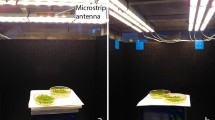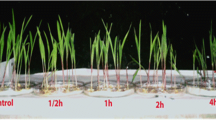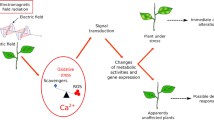Abstract
Previous studies on microwave exposure on plants have revealed variations in sensitivity of plants to different microwave frequencies, exposure durations, and power intensities. However, the effects of different polarizations of microwaves on plants have not been studied. Therefore, we investigated the effect of horizontally and vertically polarized 2 GHz continuous microwaves on Myriophyllum aquaticum plants at 1.8 W m-2 power density. The electric potential variation along the vascular tissues were investigated for 1.5 h and growth parameters, pigmentation, and H2O2 formation were studied during 48 h microwave exposure. Exposure to horizontally polarized microwaves, decreased standard deviation of electric potential variation and increased H2O2 content significantly. Vertically polarized microwaves increased the standard deviation of electric potential variation and photosynthetic pigments significantly. However, none of the polarizations altered growth parameters (shoot length, stem diameter, and internodal length). Thermographic images taken for 1 h continuous microwave exposure did not indicate alteration in the temperature of the plants for both vertical and horizontal polarities.
Similar content being viewed by others
Abbreviations
- EMR:
-
electromagnetic radiation
- EP:
-
electric potential
- hPol:
-
horizontally polarized
- on-EMR:
-
during microwave exposure
- post-EMR:
-
post microwave exposure
- pre-EMR:
-
before microwave exposure
- ROS:
-
reactive oxygen species
- Rx:
-
receiving
- SDEP:
-
standard deviation of the electric potential fluctuations
- Tx:
-
transmission
- vPo:
-
vertically polarized
References
Apel, K., Hirt, H.: Reactive oxygen species: metabolism, oxidative stress, and signal transduction. — Annu. Rev. Plant. Biol. 55: 373–399, 2004.
Ashraf, M., Foolad, M.R.: Roles of glycine betaine and proline in improving plant abiotic stress resistance. — Environ. exp. Bot. 59: 206–216, 2007.
Ben-Gal, A., Shani, U.: Yield, transpiration and growth of tomatoes under combined excess boron and salinity stress. — Plant Soil 247: 211–221, 2002.
Cheeseman, J.M.: Hydrogen peroxide and plant stress: a challenging relationship. — Plant Stress 1: 4–15, 2007.
Cho, M.R., Thatte, H.S., Silvia, M.T., Golan, D.E.: Transmembrane calcium influx induced by ac electric fields. — Faseb. J. 13: 677–683, 1999.
Dhawi, F., Al-Khayri, J.M.: Magnetic fields induce changes in photosynthetic pigments content in date palm (Phoenix dactylifera L.) seedlings. — TOASJ 3: 1–5, 2009.
Felle, H., Zimmermann, M.: Systemic signalling in barley through action potentials. — Planta 226: 203–214, 2007.
Fromm, J., Lautner, S.: Electrical signals and their physiological significance in plants. — Plant Cell Environ. 30: 249–257, 2007.
Gechev, T.S., Hille, J.: Hydrogen peroxide as a signal controlling plant programmed cell death. — J. cell. Biol. 168: 17–20, 2005.
Gomes, P.I.A., Asaeda, T.: Spatial and temporal heterogeneity of Eragrostis curvula in the downstream flood meadow of a regulated river. — Ann. Limnol., Int. J. Limnol. 45: 181–193, 2009.
Jacob, J., Chia, L.H.L., Boey, F.Y.C.: Thermal and non-thermal interaction of microwave radiation with materials. — J. Mater. Sci. 30: 5321–5327, 1995.
Janská, A., Maršík, P., Zelenková, S., Ovesná, J.: Cold stress and acclimation - what is important for metabolic adjustment?. — Plant Biol. 12: 395–405, 2010.
Kato, R.: Effects of a magnetic-field on the growth of primary roots of Zea mays. — Plant Cell Physiol. 29: 1215–1219, 1998.
Liboff, A.R., Cherng, S., Jenrow, K.A., Bull, A.: Calmodulindependent cyclic nucleotide phosphodiesterase activity is altered by 20 μT magnetostatic fields. — Bioelectromagnetics 24: 32–38, 2003.
Lindströum, E., Lindströum, P., Berglund, A., Mild, K. H., Lundgren, E.: Intracellular calcium oscillations induced in a T-cell line by a weak 50 Hz magnetic field. — J. Cell Physiol. 156: 395–398, 1993.
Moreno, J.E., Shyu, C., Campos, M.L., Patel, L.C., Chung, H.S., Yao, J., He, S.Y., Howe, G.A.: Negative feedback control of jasmonate signaling by an alternative splice variant of JAZ10. — Plant Physiol. 162: 1006–1017, 2013.
Petrov, V.D., Van Breusegem, F.: Hydrogen peroxide - a central hub for information flow in plant cells. — AoB Plants 2012: pls014, 2012.
Răcuciu, M.: Influence of extremely low frequency magnetic field on assimilatory pigments and nucleic acids in Zea mays and Curcubita pepo seedlings. — Rom. Biotech. Lett. 17: 7662–7672, 2012.
Răcuciu, M., Miclăuş, S.: Low-level 900 MHz electromagnetic field influence on vegetal tissue. — Rom. J. Biophys. 17: 149–156, 2007.
Ray, J.D., Sinclair, T.R.: The effect of pot size on growth and transpiration of maize and soybean during water deficit stress. — J. exp. Bot., 49: 1381–1386, 1998.
Reyes-Diaz, M., Alberdi, M., Mora, M.D.: Short-term aluminum stress differentially affects the photochemical efficiency of photosystem II in highbush blueberry genotypes. — J. amer. Soc. hort. Sci. 134: 14–21, 2009.
Roux, D., Vian, A., Girard, S., Bonnet, P., Paladian, F., Davies, E., Ledoigt, G.: Electromagnetic fields (900 MHz) evoke consistent molecular responses in tomato plants. — Physiol. Plant. 128: 283–288, 2006.
Satterfield, C.N., Bonnell, A.H.: Interferences in the titanium sulfate method for hydrogen peroxide. — Anal. Chem. 27: 1174–1175, 1955.
Senavirathna, M.D.H.J., Asaeda, T.: The significance of microwaves in the environment and its effect on plants. — Environ. Rev. 22: 220–228, 2013.
Senavirathna, M.D.H.J., Asaeda, T.: Radio-frequency electromagnetic radiation alters the electric potential of Myriophyllum aquaticum. — Biol. Plant. 58: 355–362, 2014.
Senavirathna, M.D.H.J., Takashi, A., Kimura, Y.: Shortduration exposure to radiofrequency electromagnetic radiation alters the chlorophyll fluorescence of duckweeds (Lemna minor). — Electromagn. Biol. Med. 33: 327–334, 2013.
Sharma, V.P., Singh, H.P., Kohli, R.K., Batish, D.R.: Mobile phone radiation inhibits Vigna radiata (mung bean) root growth by inducing oxidative stress. — Sci. total Environ. 407: 5543–5547, 2009.
Tkalec, M., Malaric, K.I., Pevalek-Kozlina, B.: Influence of 400, 900, and 1900 MHz electromagnetic fields on Lemna minor growth and peroxidase activity. — Bioelectromagnetics 26: 185–193, 2005.
Tkalec, M., Malaric, K., Pevalek-Kozlina, B.: Exposure to radiofrequency radiation induces oxidative stress in duckweed Lemna minor L. — Sci. total Environ. 388: 78–89, 2007.
Ursache, M., Mindru, G., Creangă, D.E., Tufescu, F.M., Goiceanu, C.: The effects of high frequency electromagnetic waves on the vegetal organisms. — Rom. J. Phys. 54: 133–145, 2007.
Wasternack, C., Hause, B.: Jasmonates and octadecanoids: signals in plant stress responses and development. — Progr. Nucl. Acid Res. mol. Biol. 72: 165–221, 2002.
Wellburn, A.R.: The spectral determination of chlorophylls a and b, as well as total carotenoids, using various solvents with spectrophotometers of different resolution. — J. Plant. Physiol. 144: 307–313, 1994.
Yang, T.: Hydrogen peroxide homeostasis: activation of plant catalase by calcium/calmodulin. — Proc. nat. Acad. Sci. USA 99: 4097–4102, 2002.
Author information
Authors and Affiliations
Corresponding author
Additional information
Acknowledgements: The authors would like to thank Prof. Hirofumi Kadono and Dr. Makoto Miwa for their supports during the study and Prof. Yuichi Kimura and Mr. Sakuyoshi Saito for their support in the preparation of the microwave exposure system. This work was financially supported by the Ministry of Education, Culture, Sports, Science and Technology, Japan.
Electronic supplementary material
Rights and permissions
About this article
Cite this article
Senavirathna, M.D.H.J., Asaeda, T. Microwaves affect Myriophyllum aquaticum plants differently depending on the wave polarization. Biol Plant 61, 378–384 (2017). https://doi.org/10.1007/s10535-016-0660-0
Received:
Revised:
Accepted:
Published:
Issue Date:
DOI: https://doi.org/10.1007/s10535-016-0660-0




